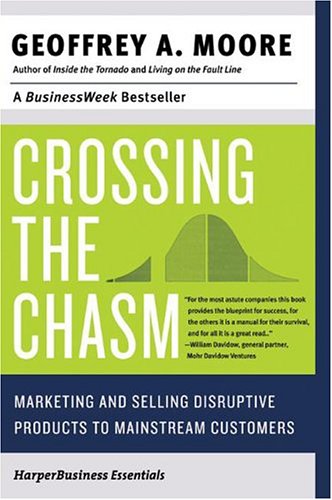 When AMD announced its cutbacks recently many people were left wondering why they were so deep given the strong financial performance in Q3 and the guidance for an up Q4. It couldn’t have been related to the Thailand floods that could have been at most a one-quarter squeeze expected in Q1. Now it is apparent from reports that AMD’s cutbacks were based on the cancelling of its 28nm APUs at Global Foundries and the time required to move to TSMC. The change will significantly delay new APU (CPU+graphics) offerings to address the low cost and “ultrabook” markets. Many companies, especially startups, choose a path that leads to Crossing a Chasm in order to be successful. Since Dirk Meyer’s exit at the beginning of the year, market forces and trends for 2012 are requiring that AMD enter a startup mentality mode and thus have to Cross a Chasm not of its own volition.
When AMD announced its cutbacks recently many people were left wondering why they were so deep given the strong financial performance in Q3 and the guidance for an up Q4. It couldn’t have been related to the Thailand floods that could have been at most a one-quarter squeeze expected in Q1. Now it is apparent from reports that AMD’s cutbacks were based on the cancelling of its 28nm APUs at Global Foundries and the time required to move to TSMC. The change will significantly delay new APU (CPU+graphics) offerings to address the low cost and “ultrabook” markets. Many companies, especially startups, choose a path that leads to Crossing a Chasm in order to be successful. Since Dirk Meyer’s exit at the beginning of the year, market forces and trends for 2012 are requiring that AMD enter a startup mentality mode and thus have to Cross a Chasm not of its own volition.
Reports earlier this week have Apple on track to be the largest PC supplier in 2012, overtaking HP. The report is based on including the iPAD tablet in the tally, which is proper. The growth of Apple is coming at the expense of all PC players in the $500+ consumer markets in the US and Europe. As a result a re-orientation of market focus has been taking place inside of Intel, nVidia and AMD. Intel has ridden Apple’s MAC coattails and that of the Windows 7 refresh in corporate, but no iPADs. NVidia, surprisingly has also done well in corporate as an attachment to Intel’s Sandy Bridge since Intel’s own graphics were viewed as under par. This left AMD with a main market focus that was the <$500 consumer PCs, especially those in the emerging markets.
AMD’s revenue growth in Q3 and projected growth in Q4 were based on the fact that Intel hit a capacity crunch on its 32nm for most of this year (a fact I noted back in July and which Jen Hsun Huang alluded to in nVidia’s last earnings call). Intel still can’t build enough high-end server processors as gray market prices remain elevated. This means they have to reallocate 32nm wafers away from low-end processors to the server brethren in order to catch up with the shortfall. AMD has thus benefitted with a nice price umbrella. Now that Intel is ramping 22nm Ivy Bridge starting this quarter, we should see PC players begin to launch new mobiles after the Chinese New Year – in the March timeframe. When 22nm starts to ramp, it is likely that 32nm capacity will open up for Intel to go back and supply more product to the emerging markets and remove the price umbrella that AMD enjoys.
The timing of AMD’s 28nm product delay is very serious as there are two underlying trends in the PC market that are dramatically reshaping the industry. The first one that is extremely beneficial to continued growth is the dramatic drop in component prices, especially LCDs that are approaching FREE$ and DRAM that can’t get much lower as a percentage of the overall BOM. The second one is the rise of the Ultrabook, which was enabled by higher density, lower cost, and much smaller footprint NAND Flash storage as a replacement to the traditional 2.5” HDD. The lower cost LCDs means more 14 and 15” notebooks selling for less than $500 and going lower (The true reason Netbooks have died). The NAND trend, means Ultrabooks like MAC Air are the second growth category, but one that can only be addressed by Intel now that AMD has delayed its 28nm APUs. The much thinner Ultrabooks require a much lower processor Thermal Design Power (TDP) of less than 7W to get maximum performance (today Intel is at 17W which means more extensive cooling and CPU throttling). Intel loves this market because they get to increase ASPs by selling the CPU plus the graphics. They also receive a premium for lower power. Expect Ivy Bridge to be delivered with a much lower TDP. As TDP gets lower and lower, the height of the Walled Garden grows, preventing a new competitive entry. Nvidia’s “Project Denver” with Windows 8 is directed at this segment.
As a Company, AMD has to hide out in the emerging consumer market until they fix their 28nm APU product line, but they don’t have long as the NAND trend will eventually make its way into the consumer markets. Today the cheapest NAND based mobile, like the MAC Air is up near $1000 but if you think ahead a couple more generations, then it is possible to see that NAND based Ultrabooks are headed to < $500. AMD needs to be there with ultra low power APU’s to meet the NAND SSD as it overthrows the long reigning 2.5” HDD. And as a final aside, they need to figure out how to get to a much lower TDP, with a smaller, more economical, right- sized die.








Comments
0 Replies to “AMD’s Crossing of the Chasm”
You must register or log in to view/post comments.